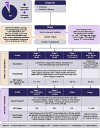Melanoma of the dog and cat: consensus and guidelines
- PMID: 38645640
- PMCID: PMC11026649
- DOI: 10.3389/fvets.2024.1359426
Melanoma of the dog and cat: consensus and guidelines
Erratum in
-
Corrigendum: Melanoma of the dog and cat: consensus and guidelines.Front Vet Sci. 2024 Jul 2;11:1442751. doi: 10.3389/fvets.2024.1442751. eCollection 2024. Front Vet Sci. 2024. PMID: 39015108 Free PMC article.
Abstract
Melanoma of the dog and cat poses a clinical challenge to veterinary practitioners across the globe. As knowledge evolves, so too do clinical practices. However, there remain uncertainties and controversies. There is value for the veterinary community at large in the generation of a contemporary wide-ranging guideline document. The aim of this project was therefore to assimilate the available published knowledge into a single accessible referenced resource and to provide expert clinical guidance to support professional colleagues as they navigate current melanoma challenges and controversies. Melanocytic tumors are common in dogs but rare in cats. The history and clinical signs relate to the anatomic site of the melanoma. Oral and subungual malignant melanomas are the most common malignant types in dogs. While many melanocytic tumors are heavily pigmented, making diagnosis relatively straightforward, melanin pigmentation is variable. A validated clinical stage scheme has been defined for canine oral melanoma. For all other locations and for feline melanoma, TNM-based staging applies. Certain histological characteristics have been shown to bear prognostic significance and can thus prove instructive in clinical decision making. Surgical resection using wide margins is currently the mainstay of therapy for the local control of melanomas, regardless of primary location. Radiotherapy forms an integral part of the management of canine oral melanomas, both as a primary and an adjuvant therapy. Adjuvant immunotherapy or chemotherapy is offered to patients at high risk of developing distant metastasis. Location is the major prognostic factor, although it is not completely predictive of local invasiveness and metastatic potential. There are no specific guidelines regarding referral considerations for dogs with melanoma, as this is likely based on a multitude of factors. The ultimate goal is to provide the best options for patients to extend quality of life and survival, either within the primary care or referral hospital setting.
Keywords: cat; consensus; dog; guidelines; melanoma; prognosis; treatment.
Copyright © 2024 Polton, Borrego, Clemente-Vicario, Clifford, Jagielski, Kessler, Kobayashi, Lanore, Queiroga, Rowe, Vajdovich and Bergman.
Conflict of interest statement
The authors declare that the research was conducted in the absence of any commercial or financial relationships that could be construed as a potential conflict of interest.
Figures


References
-
- Bergman P, Selmic LE, Kent MS. Melanoma In: Vail D, Thamm D, Liptak J, editors. Withrow and MacEwen’s small animal clinical oncology. 6th ed. St. Louis, MO: Elsevier; (2020). 367–81.
Publication types
LinkOut - more resources
Full Text Sources
Research Materials
Miscellaneous

